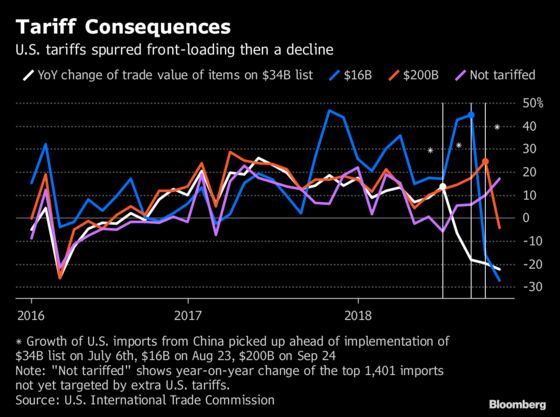As More Trump Tariffs Loom, Data Shows Grim Outlook
As More Trump Tariffs Loom, Data Shows Grim Outlook
(Bloomberg) -- With seven weeks to go until a deadline that could see the U.S. ramp up tariffs on Chinese goods once again, the economic damage wrought by the months-long trade war is becoming clearer even as a pathway to a lasting resolution remains muddied.
While Chinese goods going to the U.S. initially held up in the face of higher tariffs due to so-called front-loading, their value slumped in the final quarter of 2018, according to the latest available data. For sales going the other direction, the crunch was more immediate. In both cases, further declines are on the cards if the talks fail to produce a resolution.

Negotiators from both the U.S. and China expressed optimism after mid-level talks wrapped in Beijing this week, boosting sentiment across global markets. Still, the path forward remains unclear: Another round of talks hasn’t been scheduled, and the government shutdown in the U.S. has dominated President Donald Trump’s attention.
Both Trump and Chinese Vice President Wang Qishan were slated to appear later this month at the World Economic Forum in Davos, Switzerland, providing an opportunity for high-level dialogue. But the shutdown may yet prevent Trump’s appearance, according to a report in the Wall Street Journal.
Companies in both countries just want to see a deal get done.
“We urge both governments to use the time remaining in the 90-day negotiating period to make tangible progress on the important issues at the core of the current dispute: equal treatment of foreign companies in China, as well as China’s intellectual property and technology transfer policies,” said Jake Parker, vice president of China operations at the U.S.-China Business Council in Beijing. “Uncertainty is bad for business.”
As evidence mounts by the day that the slowdown in China’s economy is worsening, policy makers in Beijing are focusing on getting rid of the duties that Trump has leveled on Chinese goods since last year, according to a former high-level official briefed on the government’s thinking. U.S. officials appear to want to maintain the pressure of tariffs, the official said.
China and the U.S. will move ahead with trade talks as scheduled, Ministry of Commerce Spokesman Gao Feng told reporters in Beijing at a regular weekly briefing Thursday, without giving any further details over when they would take place. He wouldn’t confirm reports that Vice Premier Liu He will visit the U.S. soon to meet U.S. Trade Representative Robert Lighthizer.
Meanwhile, the economic risks are growing. Economists now see the threat of deflation in China after producer price inflation slowed sharply in December, to the weakest pace since 2016.
That would not only squeeze corporate profitability at home, but also put pressure on global price gains, as export prices usually follow those at factory gate. With industrial output and retail sales growth both at the weakest levels in a decade, China’s woes would also mean softer demand for imports, hurting other economies including the U.S.
A reduction in Chinese imports of U.S. goods came quickly after the retaliatory imposition of tariffs, the data show. Without a breakthrough in talks, U.S. corporations are likely to experience a deepening decline in their Chinese sales, with Bank of America Merrill Lynch analysts even seeing an “informal boycott” in place.

The full year numbers will look somewhat different, partly because China has resumed purchases of U.S. soybeans and other goods. Even if the current truce is made permanent and the tariffs are eventually rolled back, the damage to many companies may already be done.
China’s trade data for the full year of 2018 is due to be released on Jan. 14, and economists see year-on-year export growth slowing in December from November.
The Trump administration is pushing for a way to make sure China delivers on its commitments in any deal. Trump and Xi have given their officials until March 1 to reach an accord on “structural changes” to China’s economy on issues such as the forced transfer of American technology, intellectual-property rights and non-tariff barriers.
“The hard work of addressing structural issues to create a level playing field in China do not appear to have been resolved,” said Lester Ross, a policy committee chief at the American Chamber of Commerce and also partner-in-charge at the Beijing office of law firm WilmerHale. “And China going forward will likely still want to increase the diversification of its sources of supply even for agricultural commodities.”
The 90-day time frame is a tight window in which to nail down deep changes to China’s economic model, reforms which past U.S. administrations advocated for years and U.S. lawmakers on both sides of the aisle support.
Even so, progress in talks signals that an interim deal that suspends new tariff hikes is possible, according to Louis Kuijs, head of Asia economics at Oxford Economics in Hong Kong.
“The earlier escalation of the trade conflict between the U.S. and China and souring bilateral relations appear to have given way to a more conciliatory approach since early December,” he wrote in a note Thursday. “However, we do not see the U.S. fully removing the specter of tariff hikes any time soon.”
--With assistance from Peng Xu and Dennis Ting.
To contact the reporters on this story: Natalie Lung in Hong Kong at flung6@bloomberg.net;Miao Han in Beijing at mhan22@bloomberg.net;Peter Martin in Beijing at pmartin138@bloomberg.net
To contact the editors responsible for this story: Jeffrey Black at jblack25@bloomberg.net, James Mayger, Daniel Ten Kate
©2019 Bloomberg L.P.